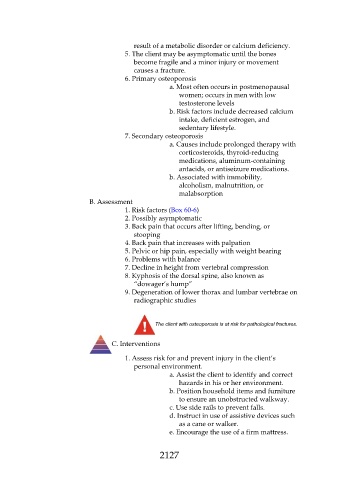Page 2127 - Saunders Comprehensive Review For NCLEX-RN
P. 2127
result of a metabolic disorder or calcium deficiency.
5. The client may be asymptomatic until the bones
become fragile and a minor injury or movement
causes a fracture.
6. Primary osteoporosis
a. Most often occurs in postmenopausal
women; occurs in men with low
testosterone levels
b. Risk factors include decreased calcium
intake, deficient estrogen, and
sedentary lifestyle.
7. Secondary osteoporosis
a. Causes include prolonged therapy with
corticosteroids, thyroid-reducing
medications, aluminum-containing
antacids, or antiseizure medications.
b. Associated with immobility,
alcoholism, malnutrition, or
malabsorption
B. Assessment
1. Risk factors (Box 60-6)
2. Possibly asymptomatic
3. Back pain that occurs after lifting, bending, or
stooping
4. Back pain that increases with palpation
5. Pelvic or hip pain, especially with weight bearing
6. Problems with balance
7. Decline in height from vertebral compression
8. Kyphosis of the dorsal spine, also known as
“dowager’s hump”
9. Degeneration of lower thorax and lumbar vertebrae on
radiographic studies
The client with osteoporosis is at risk for pathological fractures.
C. Interventions
1. Assess risk for and prevent injury in the client’s
personal environment.
a. Assist the client to identify and correct
hazards in his or her environment.
b. Position household items and furniture
to ensure an unobstructed walkway.
c. Use side rails to prevent falls.
d. Instruct in use of assistive devices such
as a cane or walker.
e. Encourage the use of a firm mattress.
2127

